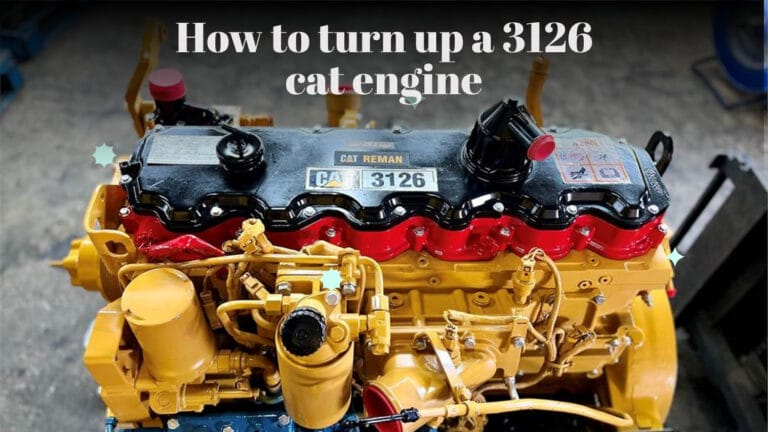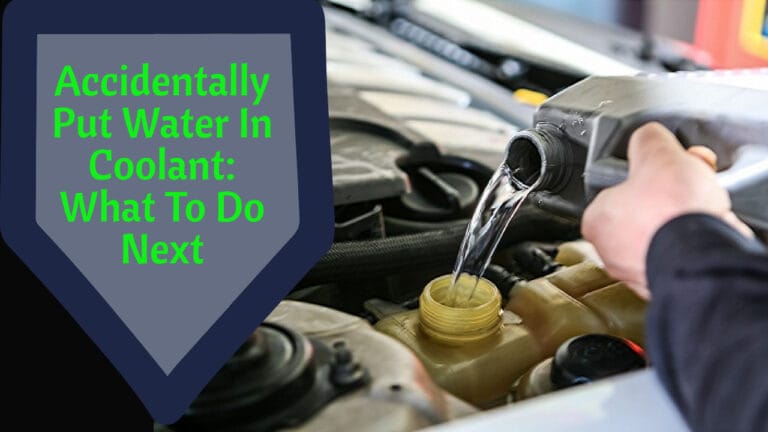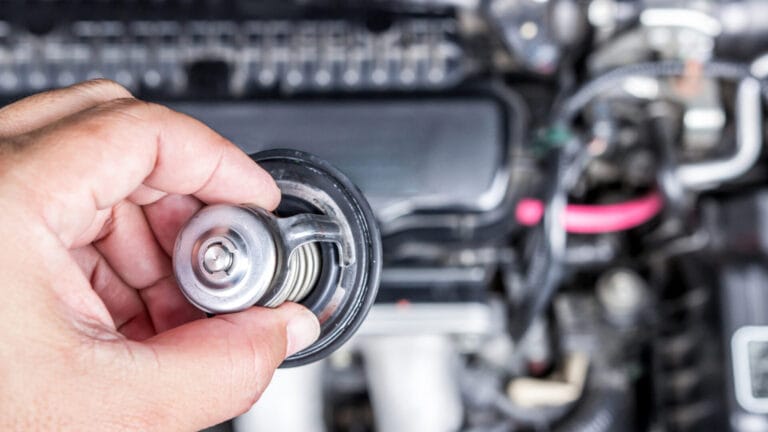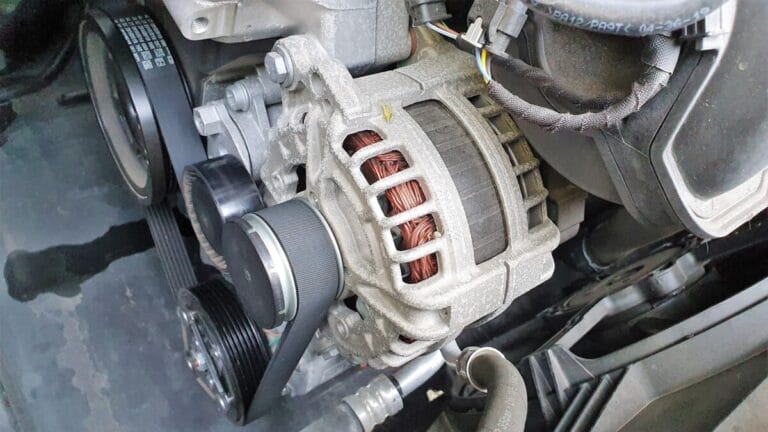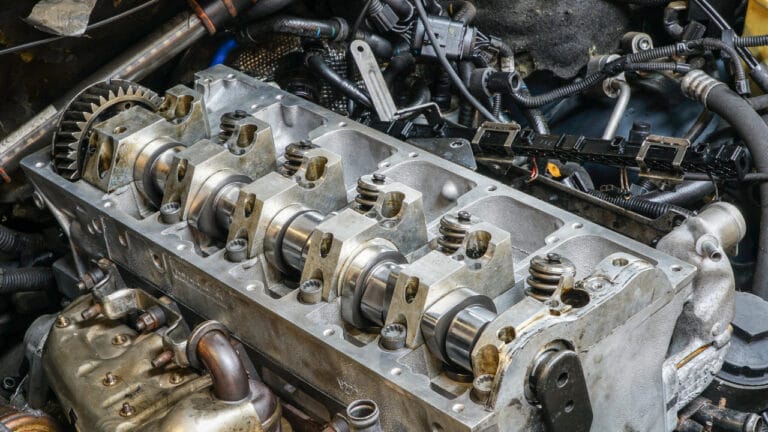Can You Drive With a Coolant Leak? Risks and Precautions
Driving with a coolant leak is akin to pushing your car to perform on an empty stomach. The consequences of low coolant levels can be detrimental to your engine’s well-being. Coolant is the engine’s lifeblood that protects your car’s engine from overheating; if it’s leaking, it can cause serious damage to your vehicle. So what should you do in that situation? Can you continue driving with a coolant leak?
No, you can’t drive with a coolant leak, even after you have sufficient coolant to reach your destination. Due to coolant leakage, the engine will be already overheated, and the coolant will run out faster than it should. Without adequate coolant, the engine will lose its ability to regulate temperature and reach its boiling point, leading to potential breakdowns and costly repairs.

A severe coolant leak might also lead to coolant mixing with engine oil, compromising lubrication and resulting in catastrophic engine failure. Driving under these conditions poses financial risks as well as safety hazards.
So, driving with a coolant leak is a gamble you don’t want to take. Its impact on engine performance, potential consequences of negligence, and safety risks warrant prompt action.
The well-being and safety of your car depend on a healthy coolant system, so when in doubt, it’s best to pull over and let your engine cool down for 30 minutes.
What is Coolant and Its Role
Coolant, also known as antifreeze, is the silent guardian, working tirelessly to ensure your car runs smoothly. Often a vibrant, colorful liquid, coolant is a specialized mixture or fluid that keeps your engine from turning into a fiery furnace. It absorbs the heat generated by the car engine and dissipates it through the radiator. This prevents engine overheating and ensures optimal performance.
However, coolant is not just a one-trick pony. Its role goes beyond temperature control. It’s the engine’s health insurance that safeguards your internal components, including the entire cooling system, from succumbing to the wear and tear caused by extreme temperatures.
What Causes Your Car Coolant Leaks
Understanding the potential causes of coolant leaks is crucial for effective maintenance and early intervention. Here’s an exploration of the common culprits behind coolant leaks:
- Consistent engine overheating
- A loose or damaged radiator cap
- Corrosion in the heater core
- Cracked or Damaged Engine Block
- A damaged cylinder head gasket
- Rust or corrosion within the coolant system
- Impact from debris, collisions, or mishandling during repairs
- Worn, cracked, weakened over time, or any type of damaged Hoses
- Corrosion, damage, or defects, any faults in the radiator
- If the water pump is damaged, responsible for circulating coolant
- Worn-out gaskets, like those around the thermostat housing or manifold
- Using the wrong coolant type or ratio can cause chemical imbalances, leading to corrosion and leaks.
Signs & Symptoms To Identify A Coolant Leak
Recognizing the signs and symptoms of a coolant leak is key to identifying issues early and preventing potential damage to your car engine.
Liquid Under the Vehicle
You may notice an unusual liquid or stain under your vehicle or see puddles of coolant on the pavement if it’s a coolant leak.
Engine Overheating
The first red flag on the coolant leak checklist is an overheating engine bay. If your temperature gauge starts creeping into the danger zone, your coolant might be making a sneaky escape.
Distinctive Sweet Smell
If you catch a whiff of something sweet, like a sugary aroma, it could be coolant escaping. If you experience this aroma, don’t let the pleasant scent fool you; it’s your car’s way of saying, “I’m leaking; give me attention.”
Warning Lights
Modern cars have smart systems that detect coolant leak instantly. If your dashboard suddenly lights up like a Christmas tree, it’s a warning light that is your car’s way of saying, “Hey, we are having coolant loss– time to check the coolant level under the hood.”
Unusual Engine Sounds or Performance Issues
Listen closely. Any gurgling or hissing sounds under the hood might be your coolant trying to make a break for it. Additionally, performance issues like a sudden drop in power or a rough idle could be linked to a coolant leak.
Frequent Top Up
Coolant reservoir demand refills without an apparent cause clearly indicate a leak. Coolant should remain consistent, so frequent top-ups suggest a hidden issue.
Visible Leaks
Visually inspect the water pump and radiator. If you notice steam or smoke rising from under the hood may indicate a leak.
How to Handle a Coolant Leak While Driving
If you suspect a coolant leak, swift action is your best bet to prevent a minor issue from spiraling into a major automotive headache. First and foremost, stay calm; panicking can impair your judgment.
Let’s know what to do in this situation.
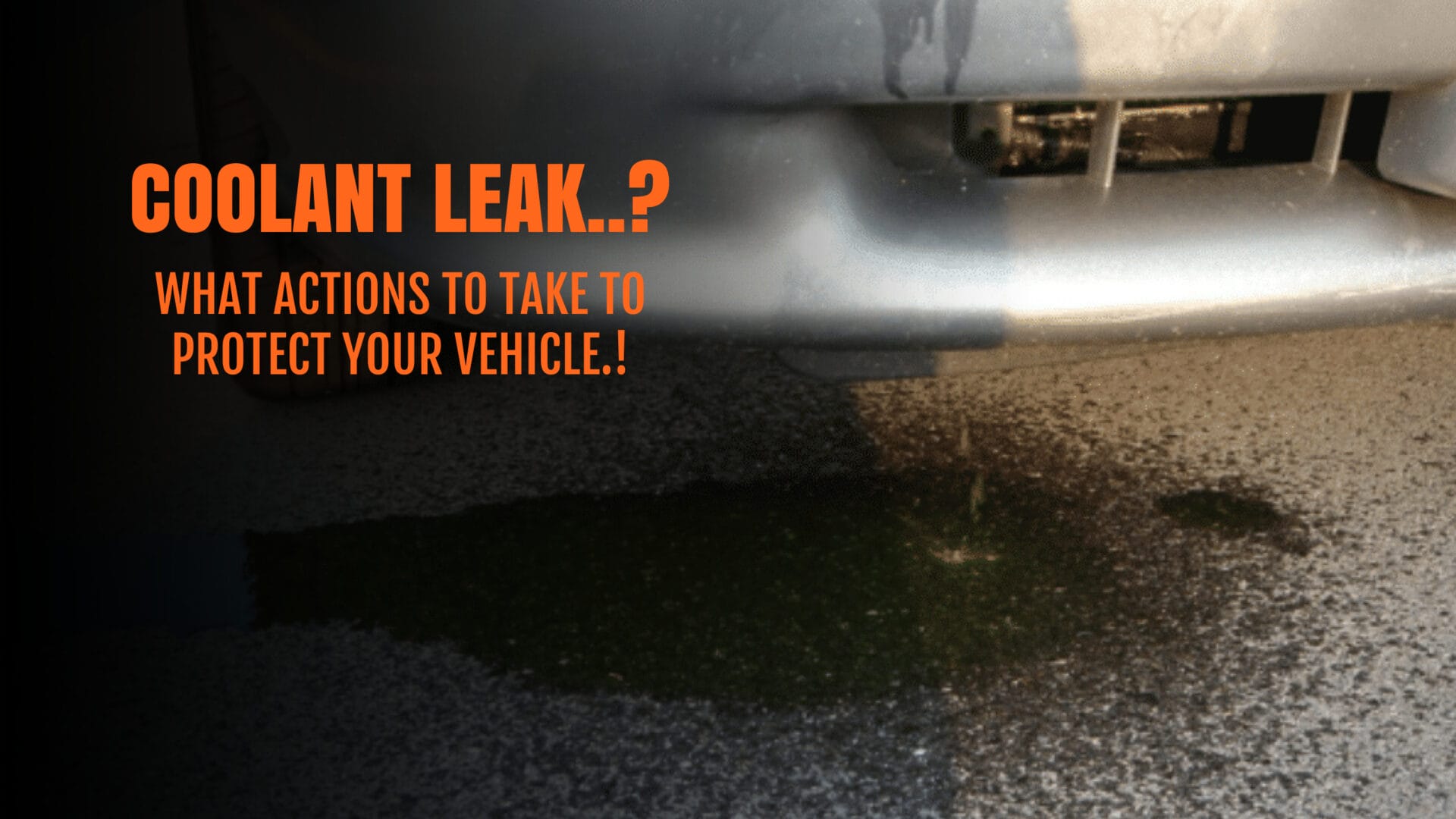
Pull Over Safely
The moment you notice any of the coolant leak symptoms, stay calm and find a safe spot nearby to pull over. If you’re on the highway, activate your hazard lights to alert other drivers that you are experiencing an issue and pulling over.
Turn Off the Engine
Once safely parked, turn off your engine and allow it to cool down before proceeding. It’s better not to touch the radiator until 30 minutes pass; it is too hot to touch now.
Check Coolant Level
After cooling down, open the hood and check the coolant level. If the coolant level is too low, but it shouldn’t be, look for visible signs and other symptoms of a coolant leak.
Temporary Solution
While it might be tempting to top up the coolant, adding more coolant without addressing the leak is merely a temporary solution. Still, you can do it if you have coolant available in the car. This will cool down the radiator faster and let you do the inspection earlier.
Call A Professional
When it’s confirmed there is a coolant leak, forget about driving the car until you get it repaired. Immediately seek professional help from a nearby auto repair shop and get it fixed.
Coolant Leaks and Driving: What’s the Risk?
Driving without proper coolant levels is like embarking on a perilous journey without a map. The potential dangers can extend far beyond a simple inconvenience. Here’s a breakdown of the risks involved:
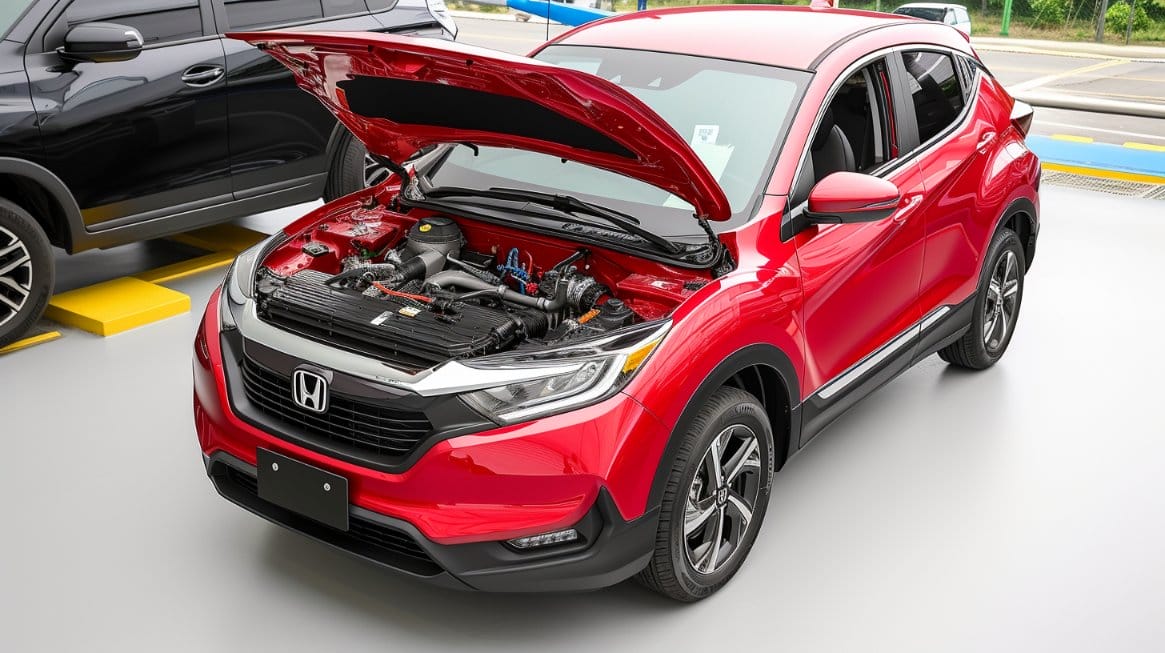
Engine Overheating
If there is a leak in the cooling system, the coolant escapes. So there is not enough coolant to circulate through the engine, absorbing its heat and carrying it to the radiator. As a result, we face engine overheating.
Increased Friction and Wear
When an engine overheats, the coolant levels drop, which means less coolant is available to lubricate and cool the engine’s moving parts. It causes the metal parts to expand and rub against each other, creating friction. This friction can result in accelerated wear and tear on the engine components, such as the pistons, cylinders, and bearings. It can also lead to irreversible damage and potential engine failure, leaking antifreeze, and even a leaking radiator.
Corrosion and Rust
You see, coolant is not just there to keep your engine running cool; it also contains special additives that help prevent corrosion and rust from forming inside your cooling system. When there is a leak, these protective additives dilute, leaving your engine vulnerable to corrosion. Corrosion eats away at metal surfaces, weakening the integrity of components like the radiator hoses and the radiator itself, potentially leading to cars engine failure and costly repairs.
Transmission Damage
Transmission and engine are closely connected; both rely on coolant for proper cooling. Due to a coolant leak, the engine overheats and puts excessive strain on the transmission, causing a radiator leak. Eventually, your radiator fluid breaks down and loses its lubricating properties. Transmission fluid leak can also cause its components to wear out faster.
Compromised Fuel Efficiency
A coolant leak can have a sneaky way of compromising your fuel efficiency. How, you ask? Well, when your engine starts to overheat, it has to work harder to keep everything running smoothly, which takes more fuel. That means you’ll find yourself stopping at the pump more frequently and watching your gas dollars disappear faster than you’d like.
Stranded On The Roadside
Due to a coolant leak, whether it’s from a cracked radiator hose, a faulty radiator, or a damaged water pump, coolant starts to escape. As the coolant level drops, your engine gets hotter and hotter until it eventually gives up and leaves you stranded. It’s like when you forget to drink water on a scorching hot day – your body just can’t handle the heat anymore!
Safety Hazards
Coolant leaking onto hot engine parts can lead to serious hazards. The release of steam and smoke can severely limit visibility, significantly increasing the risk of accidents. In extreme cases, this combination of leaking coolant and hot engine components could escalate into a fire, posing a grave threat to your vehicle and safety.
Engine coolant is not just a benign liquid; it’s toxic and adds another layer of danger. Ingesting or inhaling it can be harmful.
Tips for Preventing Future Coolant Leaks
Coolant leaks can be a real headache, but fear not! I have some tips to help you prevent future antifreeze leaks and keep your car running smoothly. Maintaining the proper cooling system will keep your vehicle’s engine running at the right temperature
Flushing and Replacing Engine
Over time, coolant can become contaminated or lose its effectiveness, leading to a potential leak. So, flush the cooling system to remove any debris or contaminants and replace it on schedule as your vehicle’s manufacturer recommends.
Check Coolant Levels
Regularly check your coolant tank and top up if low coolant level, especially before long drives. This simple step can save you in the long run. But ensure you don’t overfill the coolant tank; going beyond the maximum limit is also problematic.
Use the Right Coolant
Always use the coolant type recommended by your vehicle’s manufacturer. Mixing different coolant types can lead to chemical reactions that may cause leaks and damage.
Protect Against Corrosion
Coolant contains corrosion inhibitors, but they degrade over time. Ensure a proper balance of fresh coolant to maintain corrosion protection and prevent rust within the system.
Temperature Gauge Awareness
Stay vigilant in your temperature gauge’s readings. A sudden increase may indicate a coolant issue. If you notice irregularities, have your cooling system inspected promptly.
Regular Inspection
Remember to inspect the coolant hose, clamp, and radiator cap gasket for any signs of damage or wear during regular maintenance visits. These can be common culprits for an internal coolant leak.
Protect From Heat
Always park your car in a shaded area if possible, as excessive heat can strain your cooling system. This can be particularly crucial in high-temperature environments or when additional heat-producing components are installed near coolant lines.
Inspect Water Pump
Water pump is a critical component of the cooling system. Regularly inspect it for leaks and ensure the pump’s drive belt is in good condition. A trained mechanic can spot any potential issues before a small leak turns into a major one.
FAQ
How Long Can You Drive A Car With A Coolant Leak?
You shouldn’t drive a car with a coolant leak if the coolant level is too low. But if there is still enough coolant to go a long way, you can drive your car to a close destination. Due to the leak, coolant will run out faster than normal.
How Serious is a Coolant Leak?
A coolant leak in your vehicle is a serious issue that requires immediate attention. it can lead to overheating and potentially cause severe damage to your engine if left untreated.
Can I Drive 20 Miles With Coolant Leak?
It depends on how much coolant is left in your coolant tank. If you have more than enough coolant needed to drive 20 miles, yes, you can drive 20 miles with coolant leaks. But you should avoid this. As I already told you, with a leak, you can’t drive the same distance with the same amount of coolant you could without a coolant leak.
Is A Coolant Leak Expensive To Fix?
If it’s only about a coolant leak fix, no, it’s not expensive. It won’t cost you more than $100 if the leak is in the coolant tank, radiator hose, fitting, etc. But if it demands radiator or engine components replacement or something inside the car is the cause of this leak, it can cost you a fortune, $800-$2000.
Does Coolant Leak Repair Work?
Yes, coolant leak repair works if it’s repairable. But if the cause of the leak is something big, like engine or radiator problems, and needs any components replacement, repairing may not work, and you must replace the damaged components.
What Causes Coolant To Leak Quickly?
Internal leaks or damaged components like damaged hoses, Radiator/Heater Core leaks, Blown head gaskets, cracked engine blocks, and coolant reservoir issues cause coolant to leak quickly.
Is It Better To Use Coolant Or Water?
Obviously, using coolant is better than using water. Water lacks the corrosion protection provided by coolant and is more prone to freezing in cold temperatures.
Verdict
In essence, driving without proper coolant levels is a high-stakes gamble with your vehicle’s well-being. The risks extend from engine damage and increased repair costs to potential safety hazards. Regular maintenance, including monitoring and maintaining proper coolant levels, is a small investment that can save you from this.

